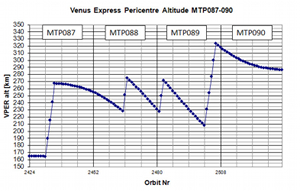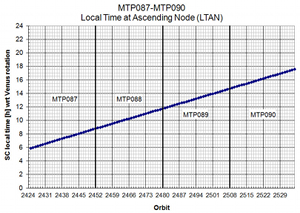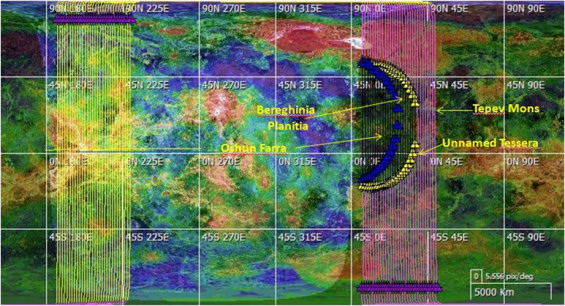No. 257 - End of the twenty-third eclipse season, end of the fourteenth Earth occultation season, continuation of the surface imaging campaign
Cebreros ground station
All Cebreros ground station activities were nominal during this reporting period.
A major software upgrade to the ground station's Intermediate Frequency and Modem System 1 (IFMS-1), was implemented over a period of four days from 12 to 15 February 2013.
The IFMS is a complex software system for telemetry, telecommanding and ranging that uses entirely digital technology. It was developed by ESA to meet the needs of Deep Space missions and is deployed throughout ESA's European Space Tracking Network (ESTRACK) system of Telemetry, Tracking and Command stations, of which Cebreros is one. IFMS merges the traditional telemetry, telecommand and ranging functions into one unit, forming the core of ground station software. It also supports high-accuracy Delta Differential One-way Ranging (delta-DOR) and spacecraft tracking.
Three copies of the IFMS software are used at the Cebreros station. One of these copies, IFMS-2, was used as the primary system for communications with the spacecraft during the upgrade. The process was completed smoothly, without any adverse effects on spacecraft or ground system operations.
High accuracy spacecraft ranging
The New Norcia and Cebreros ground stations were used for a Delta Differential One-way Ranging (delta-DOR, or DDOR) measurement at the start of the communications pass on 19 February. The measurements slightly reduced the length of the Cebreros pass and hence the volume of data downloaded during the pass.
Delta-DOR measurements are carried out with the Venus Express spacecraft on a regular basis to support the accurate determination of the ephemeris for the planet Venus that is maintained by NASA's Solar System Dynamics Group.
For more information about DDOR, see the Delta-DOR measurements link in the right-hand column.
End of the twenty-third eclipse season
The twenty-third eclipse season ended on 23 February. The eclipses during this planning period varied from 52 minutes to 6 minutes in duration.
For further information, please see Science observations with Venus Express during an eclipse.
End of the fourteenth Earth occultation season
The fourteenth Earth occultation season ended on 16 February. Seven occultation measurements were performed during this planning period - these are listed in the 'summary of main activities table' below. The New Norcia ground station was used as the receiving station for the occultation radio signal.
For further information, please see Venus Express Earth Occultation Seasons.
Orbit correction manoeuvres
Nine orbit correction manoeuvres (OCMs) were executed during this planning period – a highly unusual number for such a short period of time.
 |
|
Change in Venus Express pericentre altitude during the period from 9 December 2012 to 30 March 2013. Credit: ESA |
Six of these were apocentre lowering manoeuvres (performed at pericentre), which brought the orbit apocentre altitude down to about 66 000 km over the south pole. The other three manoeuvres (performed at apocentre) were used to raise the pericentre altitude above the north pole.
It is theoretically possible to perform each apocentre and pericentre altitude change in a single engine burn; it would also be easier for the spacecraft operations team to calculate and execute. But when necessary, for example, when the amount of fuel is low, large burns are broken up into smaller burns, to ensure that they are performed accurately.
In space, due to the absence of gravity, there is nothing to 'force' the liquid oxidizer and fuel into the inlet pipes leading to the spacecraft engines. Although the tanks are pressurised with helium to help force the fluids out of the tanks, this difference in pressure does not push the liquid oxidizer and fuel in a preferential direction. To help the fluids congregate at the entrance to the inlet pipes, screens are placed over the pipe openings. As the fuel moves around in the tanks, some (but not all) of the fluids will 'stick' to the inlet screens due to surface tension, assuring a constant flow into the inlet pipes.
In instances when missions are well into their design lifetime and the majority of the spacecraft's fuel has been exhausted, problems with the fluid flow are not unknown. The surface tension of the mesh screens over the inlet pipes will only trap a certain amount of fuel and oxidizer, and how much cannot be known in advance.
Thus, when large manoeuvres become necessary, there may not be enough fluid on the screens at the pipe inlets to support the entire burn. This can lead to 'burps', where the burn is interrupted by gaps in the flow of one or both fluids. To avoid this, the burns are broken into multiple smaller burns, over a number of orbits, so that a constant supply of fuel can be maintained during each burn.
The OCMs carried out during this reporting period were 'cool': during the OCM, the attitude of the spacecraft was such that no thermally-sensitive faces were exposed to the Sun. The burn orientations therefore did not heat up the spacecraft and it was not necessary to provide for a subsequent cooling period. 'Hot' science observations could be carried out after the manoeuvres, increasing the flexibility of the science operations.
Summary of main activities
The table below shows a chronology of the main spacecraft bus activities in the reporting period.
| Main activities during reporting period | |||
|
CEB = Cebreros; DOR = Differential One-way Ranging; DOY = Day of year; IFMS = Intermediate Frequency and Modem System; MET = Mission elapsed time; NNO = New Norcia; OCM = Orbit Correction Manoeuvre |
|||
|
MET (Day) |
Date | DOY | Main Activity |
| 2644 | 03-Feb-2013 | 034 | CEB communications pass. OCM at pericentre. |
| 2645 | 04-Feb-2013 | 035 | CEB communications pass. |
| 2646 | 05-Feb-2013 | 036 | CEB communications pass. OCM at apocentre. |
| 2647 | 06-Feb-2013 | 037 | CEB communications pass. OCM at apocentre. |
| 2648 | 07-Feb-2013 | 038 | CEB communications pass. NNO occultation pass. |
| 2649 | 08-Feb-2013 | 039 | CEB communications pass. |
| 2650 | 09-Feb-2013 | 040 | CEB communications pass. NNO occultation pass. |
| 2651 | 10-Feb-2013 | 041 | CEB communications pass. |
| 2652 | 11-Feb-2013 | 042 | CEB communications pass. |
| 2653 | 12-Feb-2013 | 043 | CEB communications pass. IFMS-1 upgrade started. NNO occultation pass. |
| 2654 | 13-Feb-2013 | 044 | CEB communications pass. NNO occultation pass. |
| 2655 | 14-Feb-2013 | 045 | CEB communications pass. NNO occultation pass. |
| 2656 | 15-Feb-2013 | 046 | CEB communications pass. IFMS-1 upgrade completed. NNO occultation pass. |
| 2657 | 16-Feb-2013 | 047 | CEB communications pass. NNO occultation pass. |
| 2658 | 17-Feb-2013 | 048 | CEB communications pass. |
| 2659 | 18-Feb-2013 | 049 | CEB communications pass. |
| 2660 | 19-Feb-2013 | 050 | CEB communications pass. Venus delta-DOR with CEB and NNO. |
| 2661 | 20-Feb-2013 | 051 | CEB communications pass. |
| 2662 | 21-Feb-2013 | 052 | CEB communications pass. |
| 2663 | 22-Feb-2013 | 053 | CEB communications pass. |
| 2664 | 23-Feb-2013 | 054 | CEB communications pass. |
| 2665 | 24-Feb-2013 | 055 | CEB communications pass. Eclipse season ends. OCM at pericentre. |
| 2666 | 25-Feb-2013 | 056 | CEB communications pass. OCM at pericentre. |
| 2667 | 26-Feb-2013 | 057 | CEB communications pass. OCM at pericentre. |
| 2668 | 27-Feb-2013 | 058 | CEB communications pass. OCM at pericentre. |
| 2669 | 28-Feb-2013 | 059 | CEB communication pass. Problems with downlink due to bad weather, ice on dish. OCM at pericentre. |
| 2670 | 01-Mar-2013 | 060 | CEB communications pass. OCM at pericentre. |
| 2671 | 02-Mar-2013 | 061 | CEB communications pass. |
At the end of the reporting period on 2 March Venus Express was at 255 million km from Earth. The one-way signal travel time was 850 seconds. The final oxidizer mass was 19.436 kg and the final fuel mass was 11.904 kg.
Scientific focus
This reporting period falls under the 89th Medium Term Plan (MTP), which covered the period from 3 February to 2 March 2013. The fourteenth radio occultation season ended on 16 February, and the twenty-third eclipse season ended on 23 February.
 |
|
Venus Express LTAN during 9 December 2012 to 30 March 2013. Credit: ESA |
This MTP was 'hot', meaning that nadir observations, if carried out, would expose thermally sensitive faces of the spacecraft to solar illumination, limiting observation times. The data rate during this period was very low, as the Earth-Venus separation approaches the orbital maximum during March 2013. Local time at ascending node (LTAN) changed from 11:45 hrs to 14:45 hrs, which meant that the observations were carried out during 'terminator orbits'.
For further information, please see Terminator orbits.
The Venus-Earth-spacecraft geometry was such that all Earth occultations and solar eclipses occurred simultaneously, after orbit pericentre. Hence, radio science occultation measurements and spectrographic eclipse observations were alternated during close approaches to the planet. Both types of observations were performed to obtain thermal sounding measurements – these provide thermal profile data for the upper and middle altitudes of the atmosphere and allow scientists to study the atmospheric temperatures between altitudes of roughly 50 to 100 km. The sounding measurements were obtained during eclipse entry and exit with the Solar Occultation at Infrared (SOIR) channel of the SPICAV (Spectroscopy for Investigation of Characteristics of the Atmosphere of Venus) instrument. Earth occultation data (acquired during Earth occultation entry and exit) were obtained using the VeRa radio science experiment.
The surface mapping campaign, begun during the previous planning period, continued in this one. Observations of the surface during the eclipse continued in at least half the orbits until the eclipse duration dropped below 25 minutes (on 16 February).
The campaign was conducted using the Venus Monitoring Camera. Heat given off by the planet's surface can be seen from orbit via one small 'window', (infrared emission at 1 micron that can penetrate the clouds) using one of the filters of the VMC tuned to this frequency. The emission is, however, somewhat distorted on its path through the clouds, so the VMC can only obtain low-resolution infrared observations of the surface of Venus, and only under complete eclipse conditions. The imaged surface targets include:
- Ishtar Terra, (55° - 75°N, 310° - 60°E)
- Bell Regio area (e.g. Tepev Mons), (27° - 37°N, 44° - 52°E)
- E. Eistla Regio (10° - 20°N, 36° - 52°E)
- Bereghinia Planitia (28°E, 39°N)
- Oshun Farra (4.2°N, 9.3°N)
- Dzalarhons Mons (0.5°N, 34°E)
- Un-named Tessera (4°S - 4°N, 36° - 46°E).
 |
|
Venus Express coverage of Venus: 3 February to 2 March 2013. Credit: ESA |
Payload activities
The science instruments performed nominally.
| ASPERA | The instrument was regularly operated nominally as part of the routine plan. |
| MAG | The instrument was regularly operated nominally as part of the routine plan. |
| PFS | The instrument was not operated. |
| SPICAV | The instrument was regularly operated nominally as part of the routine plan. |
| VMC | The instrument was regularly operated nominally as part of the routine plan. |
| VeRa | The instrument was regularly operated nominally for the Earth occultation observations. |
| VIRTIS | The instrument was regularly operated nominally as part of the routine plan. |
Future milestones
Superior conjunction (Sun in the line of sight between Earth and Venus) from 15 March to 9 April 2013, requiring science operations shutdown due to loss of downlink.
Legal disclaimer
This report is based on four ESOC mission operations reports, MOR 376 through MOR 379, as well as the MTP 89 Master Science Plan. Please see the copyright section in the Terms and Conditions for this site.



